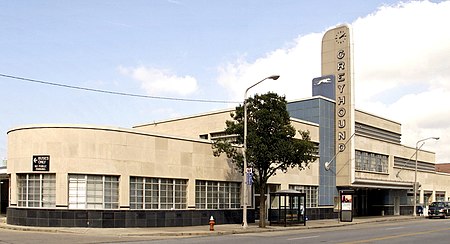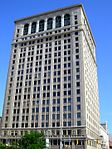Greyhound Bus Station (Cleveland, Ohio)
1948 establishments in OhioBuildings and structures completed in 1948Bus station stubsBus stations in OhioBus stations on the National Register of Historic Places ... and 6 more
Greyhound LinesNational Register of Historic Places in Cleveland, OhioStreamline Moderne architecture in the United StatesTransportation buildings and structures in ClevelandUnited States building and structure stubsUnited States bus transportation stubs

The Greyhound Bus Station at 1465 Chester Avenue, Cleveland, Ohio, is a bus station designed by William Strudwick Arrasmith in the Streamline Moderne style. Built by Greyhound Lines, it opened in 1948. It is on the National Register of Historic Places.
Excerpt from the Wikipedia article Greyhound Bus Station (Cleveland, Ohio) (License: CC BY-SA 3.0, Authors, Images).Greyhound Bus Station (Cleveland, Ohio)
Chester Avenue, Cleveland
Geographical coordinates (GPS) Address Website External links Nearby Places Show on map
Geographical coordinates (GPS)
| Latitude | Longitude |
|---|---|
| N 41.503252 ° | E -81.682228 ° |
Address
Cleveland Greyhound Station
Chester Avenue
44103 Cleveland
Ohio, United States
Open on Google Maps










